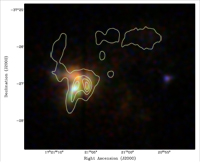Forgotten source sheds light on missing supernovae
9 June 2008
Analysis of XMM-Newton data of G350.1-0.3, together with a critical re-assessment of archival data, reveals this bright galactic radio source to be a young and bright supernova remnant (SNR). A likely associated compact object is also identified.This is the main result reported by Bryan Gaensler, Anant Tanna and their colleagues in an article to appear in the 10 June 2008 issue of The Astrophysical Journal (Letters).
Astronomers believe that a new supernova explodes in our Galaxy, the Milky Way, on average every 50 years. This number, derived from the observation of supernova explosions in other galaxies, is difficult to reconcile with the observed number of Galactic SNRs. But, the theory goes, we have until now mostly identified SNRs that are "easy" to detect through their obvious shapes: some of the others can be found by looking in regions of the Galaxy where the interaction of their expanding shells with the dense and uneven interstellar medium will have distorted their shapes, making the identification more
difficult.
 |
|
Radio and X-ray observations of G350.1-0.3. The X-ray data is from EPIC MOS1 and MOS2 (0.5-10keV) (From Gaensler et al 2008) |
In an attempt to find one of these more elusive remnants, Gaensler et al. observed G350.1-0.3, a bright radio source, with XMM-Newton.
In the 70's this source had been classified as a SNR, but a decade later its irregular morphology led to its being classified as a radio galaxy. The source lost its SNR classification, and it was later forgotten as a possible SNR candidate.
The analysis of the XMM-Newton data reveals the presence of two spatially distinct separate emission components: a diffuse one, characterized by a thermal spectrum rich in emission lines; and a compact one, with a featureless spectrum.
By combining the new X-ray data with existing information about the distribution of molecular matter in the direction of the source and with archival radio data, the authors identify the diffuse source as a young (900 years old) supernova remnant, at a distance of 4.5 kpc.
The compact X-ray source is more difficult to identify. Gaensler and colleagues suggest that it may be a neutron star associated with the re-discovered SNR.
The authors conclude that G350.1-0.3 is one of the missing galactic SNRs, a few of which have recently been identified by follow up observations of unidentified high-energy sources in the Galactic plane.
Related publications
Gaensler, B., et al, "The (Re-)Discovery of G350.1-0.3: A Young, Luminous Supernova Remnant and Its Neutron Star", The Astrophysical Journal, Volume 680, Issue 1, pp. L37-L40, 2008, doi:10.1086/589650

